Analog Domain M75D and M75P
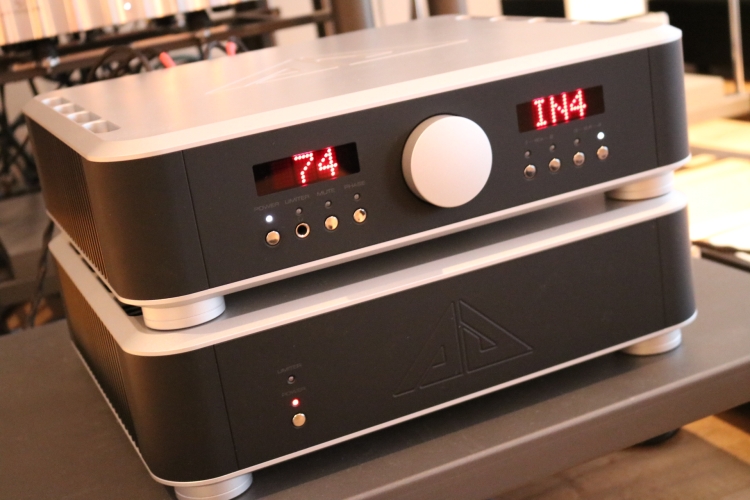
In search of the perfect amplifier
Review samples supplied by HVP Audio
Retail prices in the Netherlands:
M75P Power Amplifier: 19.600 euro
M75D Integrated Amplifier: 21.750 euro
Introduction to Analog Domain
It’s not a secret that I am a long time fan of Jeff Rowland amplifiers. I’ve owned almost the vast majority of their preamps, owned and used several power amps and owned the model sixes for almost a decade. During that time plenty other amps have visited but never did any amp fully convince me to part with the aging Sixes until recently that is.
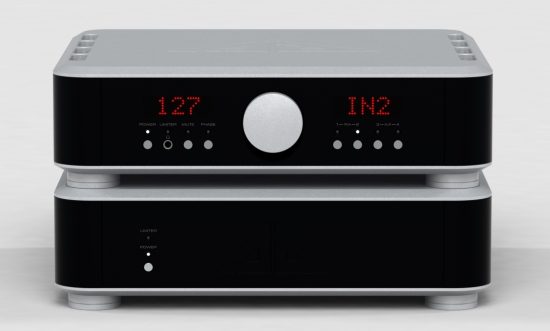
Above and below: the M75 range is available in black/black or black/silver
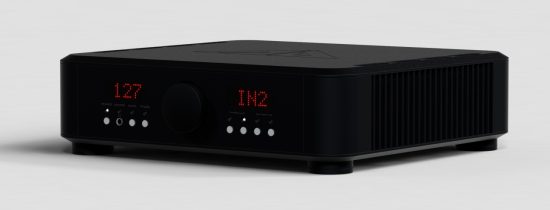
I think Hans of HVP Audio deliberately told me very little about the Analog Domain sound to let me discover it myself, but he did tell me that it was very special, different than Jeff Rowland but certainly on the same quality level as the Rowland 625 S2. He need not say more, my interest was sparked! As I was writing reviews about several speakers it seemed the perfect opportunity to review the Analog Domain gear as well while also being able to use them as references for the Wilson and Vivid reviews.
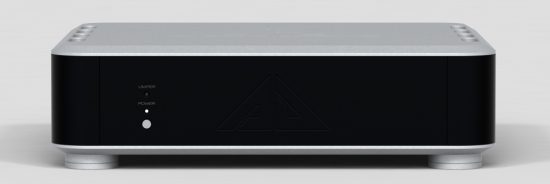
Hans was happy to deliver the M75D integrated and M75P power amplifiers and mentioned that he also happened to have a Jeff Rowland model 625 S2 in his car, which he kindly also included for comparison.
System Context
Having recently sold the Apogee Divas and in search of dynamic speakers that could deliver at least part of the Apogee dipole magic, I found a pristine set of used Wilson Watt/Puppy 8, which are the latest in this series, and took a gamble buying them. Quite unexpectedly, I completely fell for these speakers. I was actually aiming to buy new speakers but really did not expect to like the Watt/Puppies as much as I do, so, for the foreseeable future, they are here to stay. So, armed with the Jeff Rowland Corus + PSU preamp and the Wilson Watt/Puppy 8 speakers as a starting point, using the Bricasti M1 and Aqua Formula xHD DACs I set out to assess the Analog Domain amps, adding comparisons with the Vivids as a bonus.
Having lived with the Jeff Rowland model 6 amps for over a decade and having compared them to so many other amps during those years I still feel that they stand their ground in many aspects. Especially their fluidity, refinement and superb treble remain hard to beat even to this day. However, as a result of hearing more astute and dynamic sounds at shows, more and more being drawn to a less filtered, more neutral and more lively and direct kind of sound.
Now, of course, there are plenty neutral and direct sounding amps but I also want it to sound fluid, airy, full-bodied as well as dynamic, well-resolved and timbrally convincing. Finding an amp that combines all these aspects is an impossible task. Or is it?
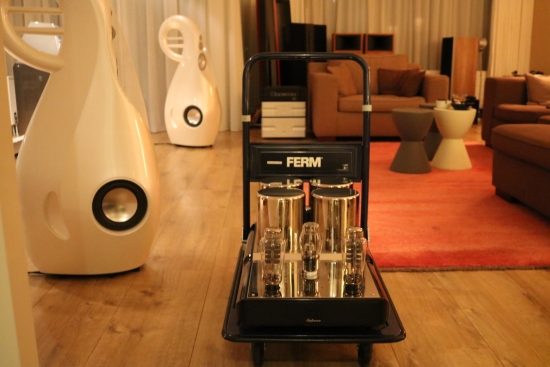
Above: due to their massive weight, the Vaics need to be wheeled in on a trolley.
The reality that I always preach is that there is no such thing as a perfect audio component. One has to decide which aspects are most important and try and find a matching product. For example, the Audio Research Reference 75 SE tube amp works surprisingly well with the Wilsons and these speakers delivered an incredibly lyrical and emotionally involving conveyance using the VAIC Reference 520 mono’s. The thing is that SET amps in generic have precious little power and only work well with efficient speakers. Even the VAIC beasts with their huge double parallel 52B triodes manage only about 50 watts with limited current and no damping factor to speak of. While they do drive the 92dB efficient Wilsons splendidly within reasonable volume levels, they definitely do not work well with Apogee Duettas at all, at any volume level. Also, they do not have the tightest or most articulate bass, which in my experience so far remains the realm of transistors. Very powerful tube amps can be found of course, with huge transformers and lots of tubes in parallel. But in doing so you quickly lose the directness, purity, and agility that the simpler designs offer.
Ok, I can let go of some of my requirements and am willing to compromise, but absolutely need an amp to sound nimble, articulate and dynamic as well as fluid, well-resolved and timbrally convincing. Oh, and I need it to be quick to warm up, be stable and reliable. Oh boy, that still reads like an impossible task. Or is it?
Amps amps amps
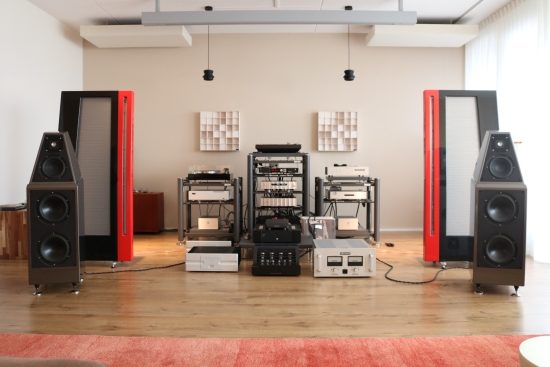
Above: Bryston 3B and 4B Cubed, PrimaLuna DiaLogue Premium and Audio Research Ref75 SE
As part of the ongoing speaker reviews there were also various amps on visit: Audio Research Ref75SE, Vaic Reference 520, PrimaLuna DiaLogue Premium, NuPrime ST-10, Bryston 3B, 4B and 14B Cubed, Mola-Mola Kaluga and prior to that also the Ayre VX-5 Twenty.
I don’t want to use this article as a shootout between amps, but in order to be able to properly position the Analog Domain amps I have made extensive comparisons and it feels like a bit of a waste not to inform the reader about some of this. So, please indulge me while I explain a little about these other amplifiers. I will arrive at the Analog Domain amps soon!
Class AB: Ayre, Rowland and Bryston
I already mentioned the Class A tube amps further above. Moving on to Class AB, the Ayre VX-5 Twenty probably has Rowland DNA because it is every bit as airy and has even better resolution than the Rowland sixes and that is saying something.
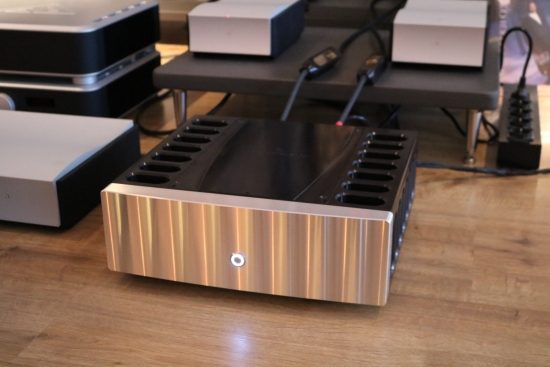
The current edition Jeff Rowland model 625 S2 is not as finely refined as the old sixes or the Ayre nor as boldly powerful and dynamic as the Brystons, but it’s not far from either extreme and strikes a very well-chosen balance between the classic Rowland smoothness and modern transparency and articulation.
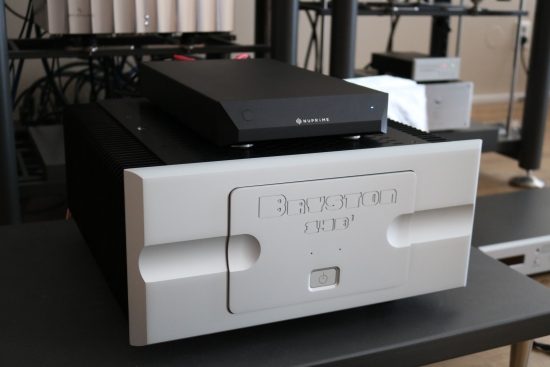
Above: NuPrime ST-10 on top of a Bryston 14B Cubed
The current crop of Cubed Bryston amps has impressed me by sounding full-bodied, rich, smooth, fluid and timbrally very convincing. In a way, they deliver much of the stereotypical class-A sound without the heat.
Class D: from ICE power via Pascal to Mola-Mola and NuPrime
Lots of articles have been written about switching amps, about their merits as well as their issues and I have also contributed my part. Prejudices are hard to beat. But by now, switching amps no longer necessarily sound overly clean, thin, rough or timbrally synthetic. For example, the Ncore-based Mola-Mola Kaluga power amps are quite costly for Ncore designs but have the fluidity, refinement and treble performance to challenge the Rowland sixes in addition to superb transparency and bass definition. Another great example is the very affordable NuPrime ST-10 which has incredible dynamics, a timbrally full and sonorous tonality and very lifelike instrumental texture. So, in a word: switched amps have come a long way. Ok, having set the stage it is finally time to start with the subject of this review.
Analog Domain – The Company
Headed by Angel Despotov, Analog Domain was established in early 2010 in Munich, Germany, with the intention of building audio gear that is able to reproduce recorded sound with ultimate sonic fidelity at realistic volume levels. Ultimate performance and unconditional reliability are two important and invariable features of all the products.
Technology
All Analog Domain amplifiers incorporate proprietary technologies such as the Excalibur topology and DXDrive. Loosely quoting from the brochure: “Excalibur refers to the output stages being connected in a “common emitter” fashion rather than the popular “common collector”, also known as an emitter follower, Darlington configuration and DXDrive technology makes it possible to take full advantage of the superior common emitter topology. One notable advantage of the Excalibur topology is its unrestricted current delivery capability. The internal resistance of the circuit is essentially zero as there is no local current feedback loop in the signal path. There are no “difficult loads” for the Excalibur. The near-zero internal resistance reduces back-EMV-induced distortion when driving loudspeakers and only protection circuits limit the current output current of the M75.”
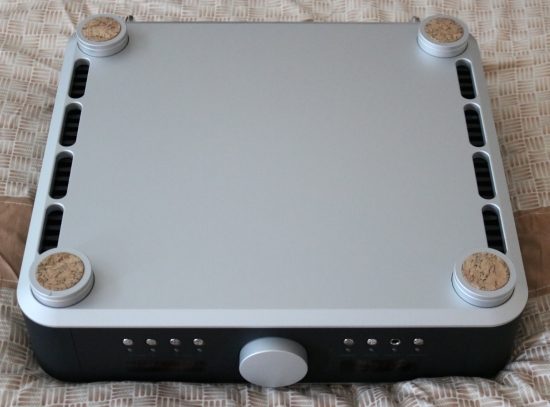
Above: no single screw in sight: not even on the bottom!
Quoting some more from the brochure: “Management and remote control functionality in the M75D are performed by a high-reliability automotive-grade microcontroller (MCU). To keep electromagnetic interference (EMI) to a minimum, all-digital drive circuits in the M75 feature slew rate limiting. Furthermore, the microcontroller is completely shut down when not active, including its system clock. If a front panel button is depressed or a command is received from the remote control the MCU will wake up to perform the desired task, illuminating the front panel display to show the operating status. After a few seconds of idling the MCU will shut down, reducing EMI to zero.” Analog Domain is entirely open about the circuits and technology that they use and much more interesting info can be found on their website. It all reads like fanatical attention to detail. I only wish that provision had been made to choose a setting to allow the display to keep indicating the current volume level.
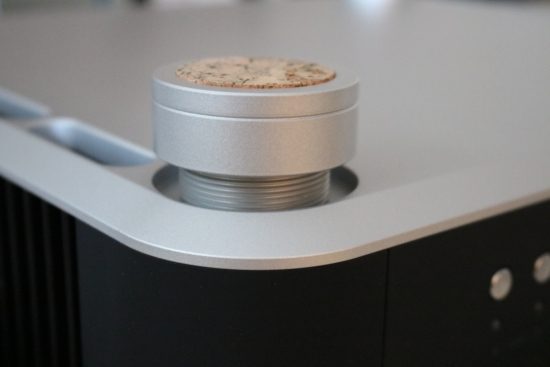
Above and below: the feet can be leveled, or screwed out completely, to reveal the fastening method underneath. Similar to classic Wadias, the Analog Domain M75 series components are assembled by clamping top and bottom plates with 4 threaded ends.
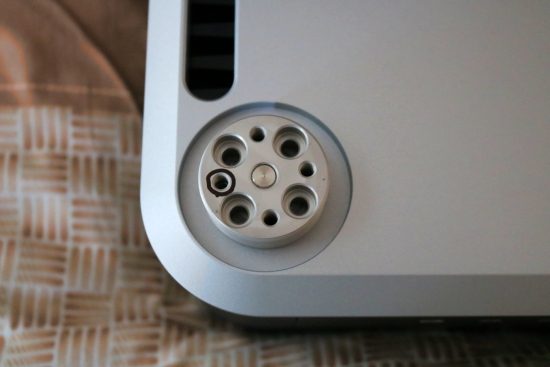
All the electronics of the amplifier are biased in class A, except for the output stages. Analog Domain considers heat the enemy, so they aim to keep it to a minimum, and this is why the output stages are not pure class A, and also because they don’t need to be: according to Analog Domain, their proprietary technology achieves the sonic equivalent of pure Class A performance without needing class A amplification. Analog Domain prefers transistors over tubes and believes they can sound just as good and when implemented cleverly, even better. While I would counter that both principles have their respective merits, each catering to different tastes, Analog Domain also indicates that tubes have a limited lifespan and a wide parameter spread for the same model, while transistors have a long service life and consistent quality and there sure is no arguing with that!
At this point, I remembered one thing that Hans told me about one of his dealers. According to Hans, the dealer had informed him that Analog Domain (no model mentioned) was the first transistor amp that he was happy listening to after always having used tubes. However, this is a tricky statement because it is open to interpretation. What exactly constitutes tube sound?
Tube sound
In my view, on the one hand, there are the typically woolly, fat and “tubey” sounding tube amps such many classic tube amps, for examples some amps made by Jadis and on the other hand, there are the lively, pure and direct sounding tube amps, such as those from Ayon and VAIC, in particular, the Reference 520 mono’s. The latter have none of the typical tube fatness and no added warmth. They sound pure, lively and direct, but instead of sounding flat like typical transistor amps can do, they really are the most involving amps that I have heard.
So, to which kind of tube sound are the Analog Domain amps being likened? I’m sure you had already guessed it… Of course, it is the lively, pure and direct kind.
M75D and M75P
The M75D and M75P are pretty much the same product, the only difference being that the M75D has a preamp section built-in and comes with remote control. The power amplifier sections are identical, and both can be bridged and/or interconnected in stereo or mono mode. When interconnected, the preamp works for both bridged power amps. Alternatively, using a jumper cable the integrated amp can also be used as a preamp or power amp.
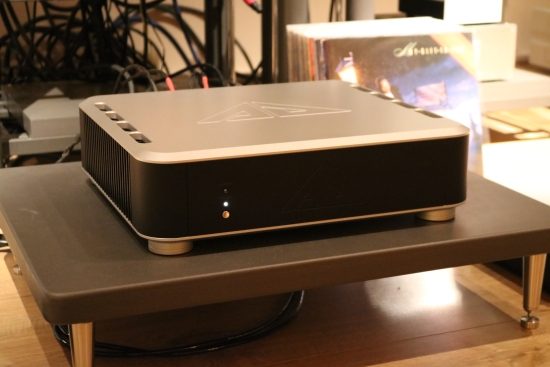
Listening
Just to be safe, I left the two amps unconnected for a couple of hours, to let them acclimatize to my warm room. I needn’t have bothered though, as the amps are sealed virtually airtight. The amps were both new and had played very only very shortly but unlike source components that I just leave switched on for a week or longer prior to listening, I just had to give these amps a listen right away and listening started with the M75P power amp.
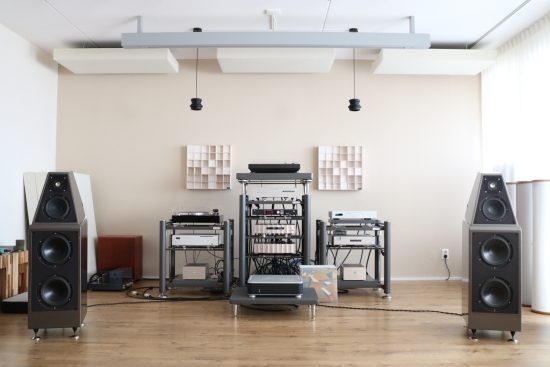
Above: Analog Domain M75P with Wilson Watt/Puppy 8
M75P Power Amp and Wilson WP8
Straight from the cold and having hardly played, the M75P matched beautifully with the Wilson Watt/Puppy 8 speakers right from the start. There is no restraint, no hardness, no glare, no blur, no coloration, just clean, pure music in all its enthusiasm and dynamic splendor. This is a very efficient class A/B power amp: it barely raises its temperature even after prolonged use. According to the manufacturer, it manages to have the advantages of Class A but not the disadvantages such as the heat. The M75P does not sound like a typical class A amp in that it does not have a warmed up midrange but there is also no crossover distortion that I can detect. The amp does not sound cold or warm, yet it is timbrally rich and acoustically very lifelike and convincing. Cross-referencing with the NuPrime ST-10, I was happy to find that the Analog Domain has a similarly neutral and timbrally correct delivery. Based on the price difference one would certainly expect the dearer amp to have excellent timbre but you would be surprised how many very expensive amps sound tonally less than convincing.
As explained further up, I like my sound pure, honest, tight and articulate and so far the NuPrime holds up perfectly. Both amps are rhythmically strong, timbrally pure and highly engaging. But I also want superb resolution and fluidity from an amp as well as refined treble performance, well knowing that it is probably an impossible task for any amp to deliver on all these accounts. However, sure enough, while not entirely reaching the exemplary low-level resolution of the Ayre, the Analog Domain amp has good resolution and fluid, smooth, non-edgy treble. It’s not the classic Jeff Rowland treble that is always silky, even if the recording is not, but rather the better-textured, more honest kind of treble that recent Rowlands such as the 625 s2 deliver. With the Analog Domain M75P, smooth recordings sure sound every bit as rich, relaxed and refined as they should while rock recordings have all the rough energy that they need. Incredibly and quite contradictory, the Analog Domain amp manages to combine extreme dynamics and raw power with superb resolution and sweet, silky treble. It’s a combination that is normally impossible to find.
When you’re young, the loudness button is your friend. But as one gets older, more and more the virtues of neutrality become obvious. More and more, it is neutrality that I crave, and the Analog Domain amp certainly overlays no character of its own, and because of this, it is able to deliver music precisely the way that it is in the recording. Do you want fat bass and creamy-smooth mids? If the recording contains it: no problem. You want relentlessly hard-hitting rock instead? No problem either.
Interestingly I could not hear any changes in its tonal presentation after warm-up, or after weeks of use for that matter. The amp is simply neutral from the get-go and remains that way. The only thing that I think I heard is that the amp seems to become more lyrical, more emotionally involving if you will, after 30 or so minutes of playing. I tend to switch off power amps after use, but because it is so efficient one could simply always leave the M75P switched on and ready to play.
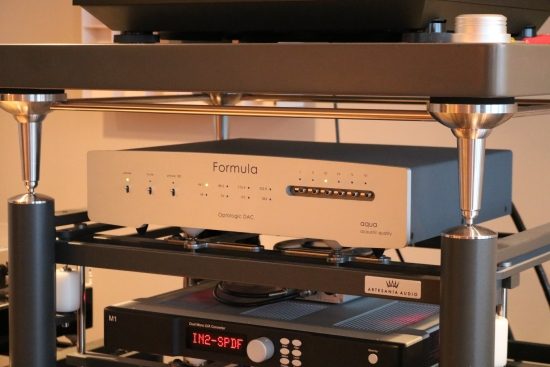
Above: the ultra-pure sounding Aqua Formula xHD and super smooth sounding Bricasti M1 DACs
As reference DACs, I use both the Bricasti M1 and Aqua Formula xHD. Both are great DACs, but very different. The Bricasti is a smooth operator with a warm and relaxed sound while the Aqua is a DAC as pure and neutral as they come. In the context of this review both DACs work splendidly but depending on taste, one or the other may be preferred. Since the Wilsons are slightly rough and a little forward in the upper midrange, some music can sound more soothing via the Bricasti and some less well-recorded music can have a higher boogie-factor through this DAC, even if it does not offer the same level of transparency as the Aqua. Nevertheless, I tend to prefer the latter because it is simply more accurate and better lets me hear what is really going on.
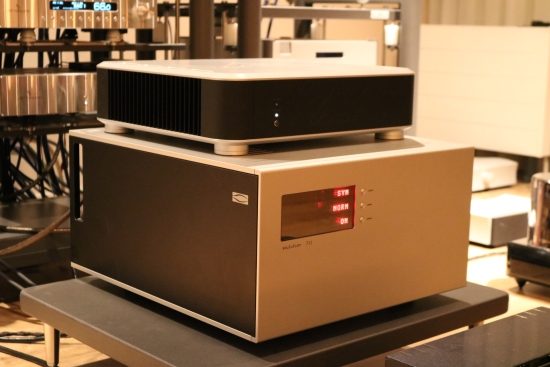
Soulution 711
After having listened to the M75P for 2 weeks, my audio buddy Niels was so kind to bring along his Soulution 711 monster amp as part of experiments for other reviews. At a whopping 55.000 euro, this is a seriously expensive amp, and perhaps out of context for this review. Nevertheless, I want to mention the 711 for two reasons. First, many people are under the impression that this brand’s amps sound cold and sterile. Maybe this is the case because the amps are often partnered with speakers which themselves have these characteristics or maybe it is because older Soulution products may have actually tended in that direction. Either way, I can confirm that the 711 sounds full-bodied, sonorous and rich and not bright or clinical in the least. Second, Soulution amps are known for their explosive dynamics. As this is one of the attributes currently most important to me, a comparison between Soulution and Analog Domain also has relevance for me personally. The 711 has Ayre-level resolution and the deepest and most well-layered soundstaging heard from a transistor amp so far. And while its sonorous bass, incredibly rich midrange and darkish tonality are quite appealing and in a way analogous to that other camp of tube amps, with the Watt/Puppy 8 or Duetta Signature, it does not sound any more dynamic or more powerful than the Analog Domain M75P. Although the 711 definitely is a fascinating amp, the M75’s more open tonal balance and the faster pace is also highly gripping.
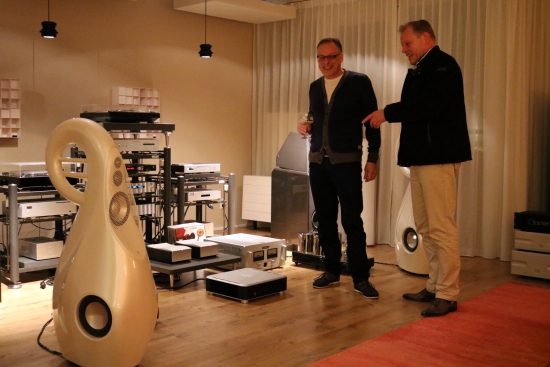
Above: audio buddies JW and JC discussing the merits of amps in relation to Belgian beers.
Vivid Giya G3 s2
Vivids are usually demoed at shows using Mola-Mola amplification. This is no coincidence, as I have been told that both parties agree that their products perform best when combined with each other. Nevertheless, it is understandable that one can grow suspicious of such a thing, and so I am fortunate to be in the position to be able to shed a light on this. Having the Vivid Giya G3 s2 as well as the Mola-Mola Makua preamp and Kaluga power amps on review as well as the Analog Domain and various other amps, I could make comparisons to my heart’s content. As this is a review of the Analog Domain amps I won’t dive deeply into it, but suffice to say that the Mola-Mola amps are indeed very good and do indeed perfectly highlight the Vivid’s strongest points.
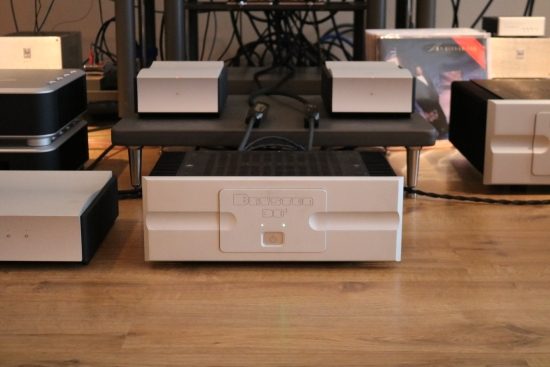
Above: Mola-Mola Kaluga mono power amps surrounded by Analog Domain and Bryston amps.
Used with the Vivids instead of the Mola-Molas, the Rowland 625 S2 sounds remarkably full-bodied and seemingly almost as powerful in the bass as the Brystons. Surprisingly it is tonally also similar to the Brystons, but it is more transparent and you do hear more nuance in all the instrumental overtones, most evident in the equally smooth, but more detailed and more clearly textured midrange. It’s still a Rowland of course, so it is still smooth, rich and relaxed and slightly warm.
Switching from the Rowland to the Analog Domain M75P, I am presented with perhaps the best blend of qualities so far. Transparency and overall resolution are very high, yet the M75P has Mola-Mola-like bass definition, speed, and pitch. Strike that, I think that its bass is even better! The M75’s midrange is special too, as clean as the Mola-Mola’s, but fuller and richer, and somehow without dulling or thickening, or losing the overall sense of transparency and definition.
More neutral than the Rowland 625 S2 but richer and tonally fuller than the Mola-Molas, the Analog Domain is timbrally impeccable. I am placing so much emphasis on timbre because I find it important for acoustical instruments and vocals to sound credible. It really destroys the illusion for me if they sound somehow synthetic. The M75 has a very lifelike tonality while being every bit as open, clean and transparent as it can be.
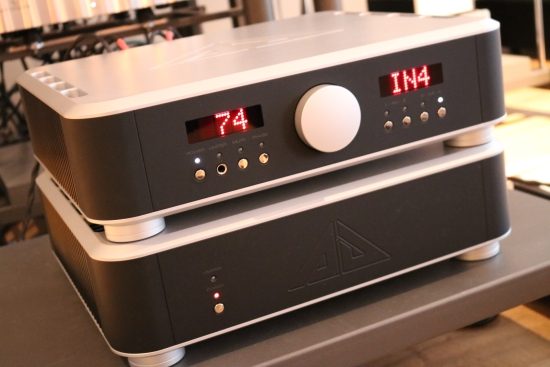
M75D Integrated Amp
Now it was time to switch from the M75P power amp to the M75D integrated amp. Taking the Corus preamp out of the equation and feeding the Analog Domain M75D integrated amp straight from the DAC, the overall balance is very similar as with the Corus in the chain, but with a little less of that seductive flair, fluidity, and air that Rowland seems to have a patent on. In its place comes a beefier bass and an overall feeling of more solidity and an even more lifelike, and actually live-like presentation. By that, I mean that even though subtle refinement is now less obvious, the overall delivery sounds even more like a live performance. This sound is even more of a whole, more earthy if you will than the more ethereal sounding Corus. Believe it or not, I really love the Corus but at this stage, I was no longer sure which delivery I preferred. Both deliveries sure have their merits.
While the MolaMolas are indeed very good, I find especially piano to sound a little more convincing with the Analog Domain especially when using both pre- and power amp sections, not because it sounds richer or warmer or anything like that, but because it better creates the illusion of strings suspended on metal mounted on wood, being hit. In other words, while I can make out all these details just as well with the MolaMola, I find the combined effect more convincing with the Analog Domain.
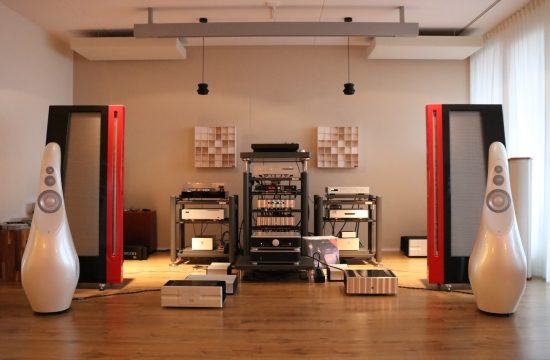
M75P and M75D in Bridge Mode
The two Analog Domain amps can be bridged to become two more powerful mono’s with built-in preamp while apparently further lowering distortion. Quoting from the brochure: “In bridged mode, the M75 is a fully differential (balanced) amplifier. The popular method of bridging is to feed the input of the inverting side of the bridge from the output of the non-inverting side. This leads to increased distortion, among other issues. When the M75 is operating in bridged mode, the balanced inputs of power stages are connected in inverse parallel, producing two identical, mutually inverse signals at the outputs. With a matched gain to within 0.1% there is no loss of performance in bridged mode; in fact, performance improves over single-ended mode as the even harmonic distortion products cancel out.”
After configuring them this way by means of a couple of switches on the rear and relocating the cables and using a jumper cable, immediately I heard that Hans was not at all exaggerating when he said that the Bridged configuration would be something else. Tightness, drive, power, dynamics, and transparency further increased while retaining all of the amp’s virtues. Oh boy, one amp sounds really great but after hearing them together it’s tough to go back!
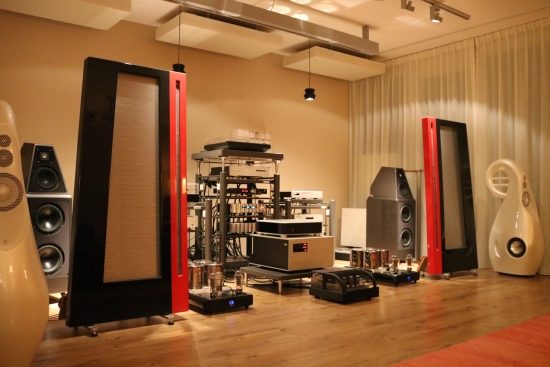
Apogee Duetta
Regular readers will have read plenty of my adventures with various Apogee ribbon speakers. After having sold the Divas, remaining at this time are only my friend JW’s speakers which are the Duetta Signatures which have recently again been refurbished which is why I refer to them as being “re-refurbished” and the original Centaurs, both on super-extended stay at my place. The Divas sure have made life difficult for me, sounding smooth and relaxed while being capable of portraying the subtlest of nuances but needing copious amounts of power. It’s too bad that the speakers are no longer here to try it but I’m sure that a stack of Analog Domain amps would have been just what the Divas needed. But just for fun, I dragged the smaller Duettas back into position and connected the Analog Domain amps. Whoa, yes indeed, this was pure fun! Even in single-ended mode, the Analog Domain amp had excellent control over the Duetta’s woofer ribbon while allowing the midrange to bloom and all the while not allowing the mid-tweeter foil to harden up at any sound level. But when going to bridged mode the fun seemingly doubled! While beautiful before, especially in this mode the performance had a distinct live-like performance. The power and dynamic behavior really was something quite out of the ordinary. The difference between using the Corus and going all Analog Domain was the same as noted above: more airy and refined and more gentle via the Corus, more powerful and tonally pure using the Analog Domain preamp.
Conclusion
Much of why I find the Analog Domain amps to sound so appealing I think has to do with the immediate dynamic attack and the lack of blur. They unravel any recording with incredible ease, yet avoid sounding overly clean. Both the M75D integrated and M75P power amp are fast-paced and articulate, highly detailed, incredibly rhythmic and dynamic and lifelike, with power to spare. It’s not all muscle though: they have a highly neutral yet superbly textured and lifelike midrange and smooth, fluid treble. All these terms serve little purpose if they did not culminate in an involving sound, but that’s just the thing: in spite of all the technical excellence, the amps are uncomplicated music makers!
So, are they the perfect amplifiers? Allowing for the idea that there may not be such a thing as a perfect amplifier, the Analog Domain amps sure come very close. I have heard amps in my system that possess a more glowing midrange and have more lyrical qualities but these may very well be sins of commission. The question is: do you want the truth, or something prettier? The Analog Domain amps manage to tick all of my required audiophile boxes and sound above all just incredibly honest.
One could desire certain editorializing from an amp, for example for it to add extra richness to the music or to make it more soothing by fattening the bass or rounding off the sound altogether. Although the Analog Domain amps possess certain tube characteristics, they are not the equivalent of a typically “tubey” or “phat” sounding tube amps. Rather, both amps do incorporate a very big portion of the midrange purity and natural timbre that the best tube designs such as the Vaic Reference 520’s are capable of. Ultimately though, rather than likening the Analog Domain amps to typical transistor or tube amps, I’d say that they sound like no amp at all, and as an added bonus, thanks to their high power and near zero internal resistance, these chameleons are capable of driving any speaker load.

External Links
Manufacturer: Analog Domain
Distributor for the Benelux:
HVP Audio
Prinses Irenelaan 218
2285GB Rijswijk
Nederland
Telephone: +31 61 492 69 47
Website : www.hvpaudio.com
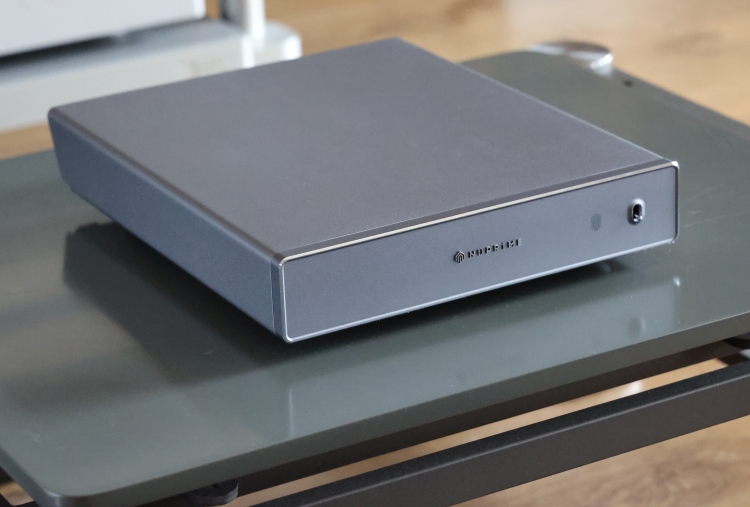
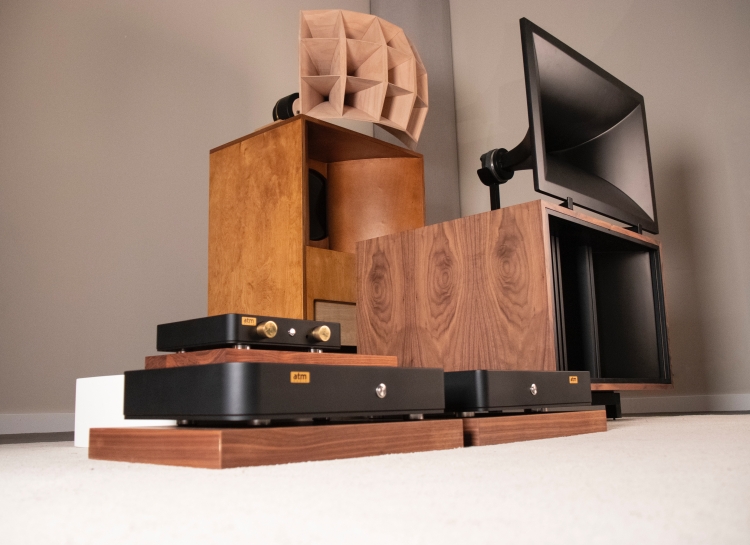
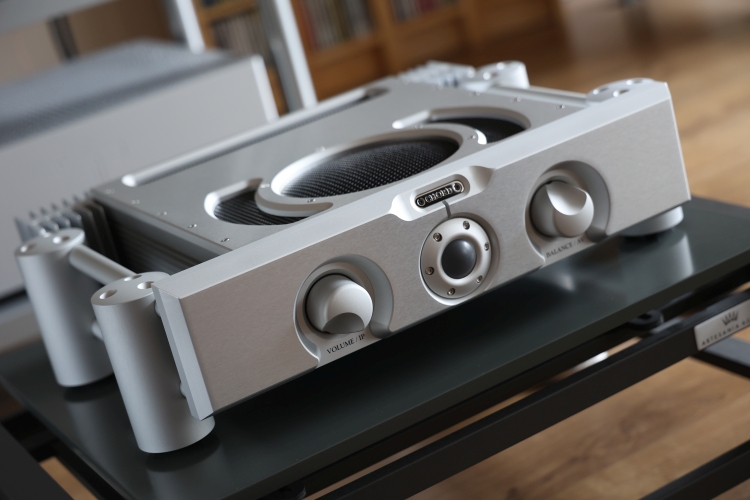
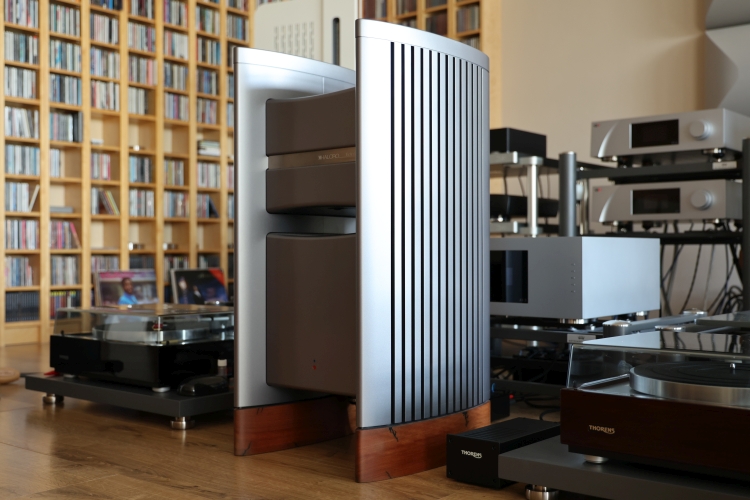
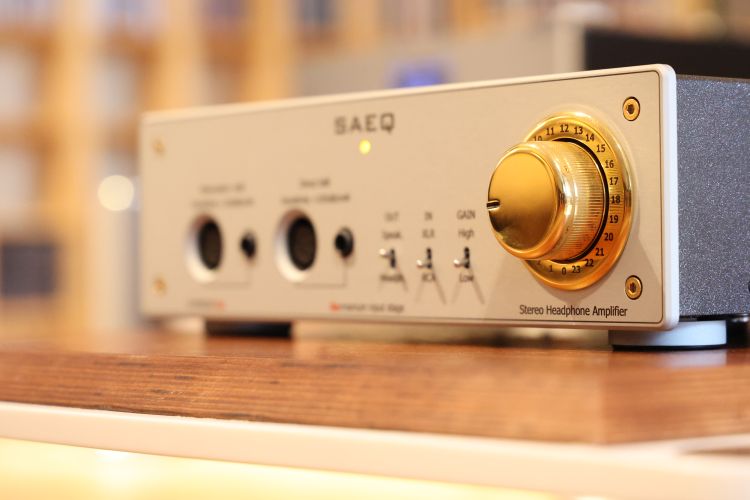
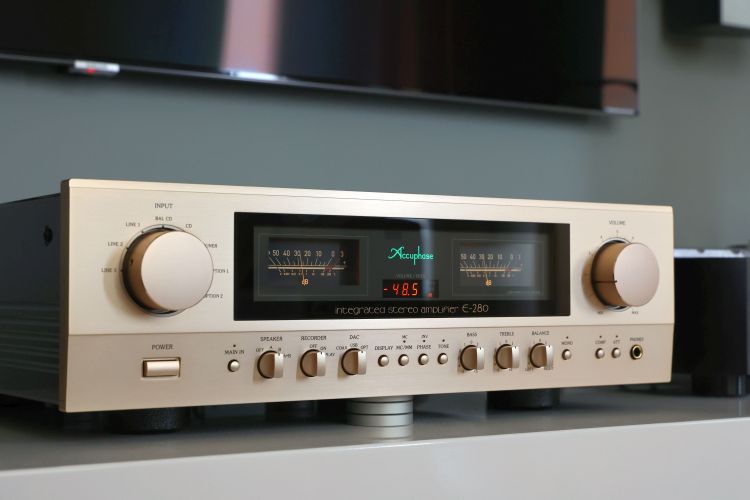
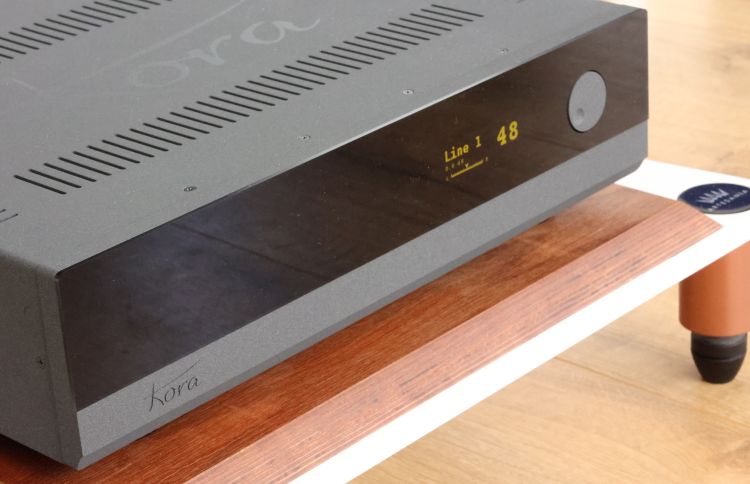
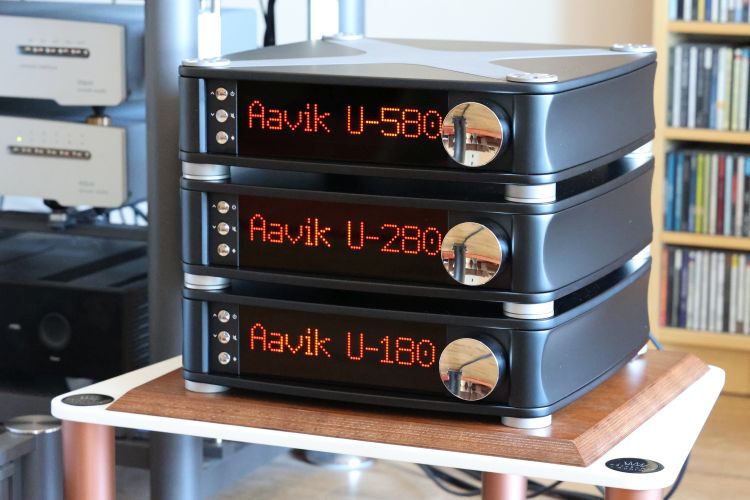
Thank you for a very interesting and thoughtful review. I was wondering if you had the opportunity of trying the Mola Mola Makau pre/dac with the Analog Domain Power amp?
Hi Robert, I’m afraid that was a combination that I have not tried. Given that AD have an integrated amp with an excellent pre amp built in it’s probably not a combination that people are likely to make. That said the Maku has phono and DAC built in and also sounds very neutral and refined and has superb configurability, even allowing phono settings to be changed from the ipad or remote.
Hi Christian, thank you for your reply. Perhaps a more appropriate combination would be Mola Mola Tambaqui/AD integrated.
I look forward to reading your review of the Mola Mola Makua/Kaluga in due course. I am delighted with this combination, being both neutral, open and textured with body. Sounds like a very good red wine, tastes. In our direct experience of the Makua pre/dac it has seen off Dave and Nagra and I have read reports of it besting dCS and Weiss dacs. The AD I would like to try sometime but it is a more expensive option if you factor in the extra cost of a dac.
Alas, the Mola-Mola amps will not be reviewed. They were supplied together with the Vivid Giya G3 s2 and only assessed as part of that review. As such I have not done extensive tests such as comparing the Makua’s DA section vs external DACs. I did briefly compare the Makua as a preamp using analog inputs versus the Rowland Corus and it certainly held up extremely well. Separately I also used the Makua with its integrated DAC section later, also with great results. My impression of the Mola-Mola products is indeed that of very neutral and refined delivery. The AnalogDomain amps also sound very neutral but are balanced differently. The latter’s presentation (used either as a power amp fed by the Rowland Corus or integrated amp) tends more toward a sonorous and earthy sound while Mola-Mola’s presentation (used either as power amps fed by the Corus or as a complete Mola-Mola system, tends to be airier and more light-footed. The Makua preamp is more neutral in this respect than the Kaluga power amps.
Have you tried decent McIntosh amps? I had never heard any til recently and holy-moly… never heard better amplification – huge, smooth, sweet yet detailed, dynamic and utterly transparent. I can’t personally afford them right now, but since you review fairly esoteric gear, they might be worth a listen.
So far I’ve only used the MA-6900 in my system. While definitely very good in many areas I found it lacking in fine detail (refinement) and treble air. But that’s not to say that all Mc amps are the same. If I get a chance to listen to a more recent model or a power amp then I will do and report on this.
Did you mean the MA6900? If so, it’s a good amp, but well below the price range of what you normally listen to, or review, so not surprised you found it lacking comparatively. Have fun if you listen to a good Mac pre/power, or something like the MA9000!
Fair enough! I have a feeling that the lack of refinement, focus and treble air is the price to pay for the high power and great control, not only for this Mac. It’s usually not until you spend gazillions that refinement goes hand in hand with power and drive. That said, I also have a feeling that the darker, rounder, more “global“ sound of the MA6900 may be the Mac company sound. But this remains to be seen if/when I get my hand on higher end Mac products.
Rich answer from an experienced adviser 🙂
The progression specs looks impressive. I hope they are not overkill and they worth the double price compared to the Classic.
Thanks!
Anas
Hello christiaan,
Thanks for the review, I very much enjoyed it!
I just bought the Focal Marstro speakers and I am looking for the right amp as those towers are demanding to deliver their best.
My main use is 50% music and 50% for home theather movies in kind of Atmos setup.
I am getting lost with all the amp alternatives and was about to decide for the new nc611 however reading about rhe M75D is making me think twice.
What would be your revommendation?
Thanks,
Anas
Hi Anas, sorry, I have no clue which amp is referred to with “nc611”.
Sorry I meant the macintosh MC611. so far in my short list:
1. Analog Domain M75P
2 Jeff Rowland Design 625 S2
3. Dan d’agostino classic stereo
4. Mcintosh MC611
Primary objective: To feel the immersive sound of my BD movies with ATMOS/DTS:X track audio (I use Trinnov 32 as processor.
And also I want to have the best of music listening (kind of Daft Punk music).
Thanks!
Anas
Ah, I see. Well, there is not really a “the best”. All the amps you mention are fine specimens and all can drive the Maestro’s just fine. It comes down to personal taste and which aspects you find most important. The Analog Domain is most neutral and transparent and likely also the most detailed, the Rowland is the smoothest, a bit polite yet still very finely detailed, d’Agostino Classic Stereo is ballsiest but less refined and the Mac is a bit like a mix between modern Brystons and the d’Agostino in overall sound balance. of the four amps, the MC611 and Classic Stereo sound beefiest and provide the most bass pressure, they’re most “impressive”, which I have a feeling may be what you are after for cinema use and maximum Daft Punk impact. If pressed between the two, I’d choose the MC611 over the Classic Stereo, but then again I’d opt for the d’Agostino Progression or Momentum over the MC611.
Thanks dear Christiaan for your quick and elaborated reply!
In your last sentence “, but then again I’d opt for the d’Agostino Progression or Momentum over the MC611.” Do you mean that in the context of Cinema/Daft Punk listening or you mean for your own personal preference?
Did you demo the MC611? I have read that the previous version MC601 was not that convincing performance wise and mostly for Dynamics. Mcintosh claims 50% increase in dynamic.
I am open for other alternatives if you have recommendations to at most double budget, however, I don’t need an amp that’s beyond my Focal maestro capabilities.
Cheers,
Anas
The Focals are very capable speakers and they will benefit from the best amplification that you can get but it depends on your expectations. Some people want a powerful sound, others a refined and detailed sound. The Progression is a cut above the Classic Stereo in many aspects and I would prefer it for its overall capabilities, including refinement and resolution. If bass power and dynamics are most important, then Classic Stereo and MC611 are also great options. BTW the 611 is more immediate indeed but that 50% increase should be taken with a pinch of salt:-) Dynamics are a relative phenomenon, everybody perceives this differently and often a “loud” or “energetic” sound is mistaken for being very dynamic. Actual dynamics are not usually perceived as such. In the case of McIntosh, it ties in more with hysteresis, lack of speed and rounding of transients more than actual dynamics per se. Amps with less power tend to be more dynamic (and sound more dynamic, too) than super powerhouses but the d’Agostinos are something of an exception to this. in fact, I’d like to change my advice to not going for these monster Mac Monos but going for Progression or a nice stereo McIntosh such as the MA7000. Truly, you do not need the 1000+ watts that the big Macs have on tap unless you have no neighbors and predominantly play at even higher levels than at cinemas.
I posted my answer on the post below!
Rich answer from an experienced adviser ?
The progression specs looks impressive. I hope they are not overkill for my Cinema use and they worth the double price compared to the Classic.
Thanks!
Anas
Well, for cinema use you don’t need a superlative amp such as the Progression. For music playback, however, it is much better than the Classic Stereo. The Progression is Powerful, subtle, airy and refined, the Classic Stereo is mostly just Powerful. If I were you I would ask to get both on a demo in your home and decide after that. If cinema is the main use, however, then I’d advise to save some cash and get a Bryston 4B SST. You’ll likely be surprised at how good it really sounds, besides being super-powerful. Oh, and you can’t beat that 20-year warranty!
Money wise I found 2 deals ending up on the same price on two mono MC611 and on the Dan d’agostino progression stereo.
If I get you right, with the Progression I will have the same rich/dynamic/bass/immersive cinematic experience as the MC611 but on the top I will have better music experience, right? I do not watch movies too loud, my Trinnov processor never exceeds -20db as it too much for my 30m2 room.
While I have not compared these two amps directly I am pretty sure that Progression will outperform the big Macs or at least equal them on most of their typical aspects, including perceived power, even if the specs don’t seem to indicate this in terms of wattage. But when it comes to power, it’s not only about watts. These amps do not sound the same but yes, I’d say that the Progression will offer the qualities relevant for you (rich/dynamic/bass/immersive and more) of the Macs and add to it more resolution and refinement for a more involving music experience. Indeed, if it were up to me, in your situation and with your preferences I would opt for the Progression over all the other options. Even more dynamic or more articulate sound can be had by using other brands but these will either provide a less fulsome (more analytical) sound or won’t be ideal for power purposes in generic or your cinematic experience in particular, or are even more expensive than the d’Agostino Progression. On balance I think you will be served best with the Progression. Do let me know how you get on!
I sent you a private mail if you could please have a look.
Thanks!
Anas
Hi Anas, having looked at your email, my personal preference and advice to you remain unchanged. Do note that if I were you I would get both the Classic Stereo and the Progression in for a demo and let your ears be the judge. The money difference is too large to let this depend on me:-) Maybe you can also get a Progression amp second hand?
Great advice indeed as I am not in hurry I can afford to wait finding the right opportunity. 1st quick search on sale items, there can be great opportunities on the Momentum preamp/amp package!!!
I appreciate very much your expertise and dedication dear Christiaan!
Anas
You’re welcome Anas:-)
Another dilema dear Christiaan, which bundle is better on the Progression line;
1. Preamp+ stereo
2. Two mono
Cheers,
Anas
Honestly, I couldn’t say Anas. I’ve no experience with the Trinnov and have not compared the Progression preamp with anything. From experience with other amps, though, I’d say that bridging does not always lead to better results. Doubling up can have certain benefits but certainly does not always yield a subjectively more powerful sound. Also, I think that a single amp will easily be powerful enough for the Focals.
Don’t forget that bridging, while increasing voltage swing, also halves the damping factor and doubles the minimum impedance requirement, so it’s not a cure-all.
That’s entirely correct James – when speaking of series bridging. Some amps (the Bryston 7B ST’s for example) can be also bridged in parallel mode, doubling current in the process. But this method is also not a cure-all. More transistors do not always equal better sound. It’s all very relative!
Thanks guys for your feedback!
Quality is what I am looking for and not too much power as I do not listen too high to music.
Cheers,
Anas
I didn’t realise Bryston’s allowed parallel bridging – interesting! But yes, I agree, subjective sound quality may well not be better by bridging – and the knee-jerk idea that it will simply give you ‘more of the same’ may well not be the case in practice.
Indeed James! Do note: while the 7B ST offered this option, the current SST3 (Cubed) Series do not.
Order trigred for the progression stereo and preamp with the digital option. To be delivered in a month 🙂
I am looking now for the subwoofer setup with the focal maestro for cinematic use. I read the more subs the better. The room is 37m3 and wondering to go ported or sealed . What are your thought? Whats subs you recommend?
I have now the B&W DB1D.
Cheers,
Anas
Congrats, Anas! While I am no any kind of authority on subwoofers I can add the following. While multiples can work better, they can also actually work less well, depending on room interactions. Oftentimes, with asymmetrical rooms or when one side is windowed and the other a (concrete) wall, one or the other wall will work better for a subwoofer, meaning that one sub will be better than two in this case. In general, if the crossover is set low enough (40hz), then they are not very directional at all and using a single sub on the left or right corner works just fine. Also, in general, closed cabinets tend to sound faster than ported ones. As to which brand I can’t really advise as I’ve only ever used REL Strata III and Quake II which are great for the price but I’m sure one can do better. Also read my REL reviews and please comment there if you have further questions.
In my search on subs setups I found this one which is quit unusual!
http://audibleimagesav.com/2018/04/23/rel-g1-mark-iis-really-earn-name-rock-gibraltar-system/#respond
Would there be tremendous benefit from this huge subs investment?
The subs question is not at all related to the Analog Domain amps. Please can you try and post comments under relevant articles, for example the REL reviews as linked below. You can also always search using keywords via the on-site search.
https://www.hifi-advice.com/blog/review/loudspeaker-reviews/rel-quake-ii-and-strata-iii/
Hello Christiaan,
I was lucky to be able to borrow an Analog Domain M75D (int.) for 6 weeks and in my ears the strength of this amp. is the midrange. Speech is very resolved and with a convincing texture, something of the best I have heard from a transistor amp. so far. Acoustical instruments are superb. Treble is soft and fluid, never gets hard or edgy, but I get the feeling that is a little bit rolled off. Would have preferred a bit more air and openness in the top.
The bas also give me the impression of being slightly rolled off. Would have preferred more attack and dynamics in the low end. The sledgehammer feels more like a plastic club. It is a little bit too polite overall. Music with high energy never really takes off from the ground.
I’m very curious about the Grandinote Shinai. Not so much power on the paper, 37 W, but I have heard some terrific demos. Very fast and natural sounding. Any plans for a review? German magazine AUDIO gave the Grandinote mono blocks perfect score, one of three amps. in the 40 years history of the publication.
Kind regards,
Hi Per, I heartily agree that the midrange is this amps most appealing quality is its midrange and I also agree that there are amps with airier, seemingly more extended, treble. The bass, however, while not the most full-bodied, in my tests with the Apogees and the Wilsons was definitely fast, dynamic and articulate. It’s maybe a little dry, though, indeed in terms of bass, it’s not a Krell, Bryston or Soulution. The Grandinote Shinai looks like an interesting piece indeed. I’ll see if I can get it in for review.
Beste Christiaan. Mooie test. Ik ben benieuwd of de Goldmund telos 590 voor jou even goed is als de analog domain. Ik heb de telos thuis gehad, maar er trad een storing op in de set zodat ik niet eens kon luisteren.
Vond het wel wat lichtvoetig en upfront.
Groet,
Frans
Hi Frans, I feel that many amps have (overly-) fat bass. Many have what I feel is bass that is bigger than life. There’s nothing wrong with that but when encountering an amp with very accurate bass such as the Telos 590, it can be seen as lightweight. However, I don’t personally feel that this is the case. It is just very accurate and very clean. That said, I understand why you would feel this way and after all an amp simply has to fit your system and preferences. Also, I can definitely understand that one could feel that the Telos 590 is not exactly romantic. Indeed, it does not warm up the sound and it does not add any richness or bloom to the midrange.
For me, the Telos 590 and the Analog Domain M75 are very close in terms of overall character. Both are very neutral and precise and have that tight and articulate bass, the overall lack of smear and the clean midrange. If you find the Telos 590 too lightweight and upfront than I think the Analog Domain would also not be ideal for you. The main differences between the two, in hindsight, are that the Telos is slightly higher res and the AD is slightly darker in the upper treble.
Ik heb nu nog de Aavik. Ik berichtte je ook dat ik nauwelijks kon luisteren naar de Telos. Ik denk dat het lichte wel wegtrekt als Telos opwarmt. Ik denk dat ik maar naar de Soulution ga kijken of de ypsilon phaeton.
Dank je voor je testen!
Frans
Hi Frans, I only heard the Aavik at shops but based on that, I think I should state for the record that it is very linear from top to bottom and it does not at all have fat or overblown bass so that negates my previous comment. However, the Goldmund is quite lively and indeed perhaps a little bit more forward than the relatively calmer and more calculated Aavik. Warming up does not do much to change the 590’s overall balance but it does make the midrange slightly warmer and less forward. I’d be interested to hear how your repeated test with the 590 and the tests with the Soulution (300-series, I presume?) and the Ypsilon work out.
There were revisions of the original and then a Mk2. Which version of the M75D was reviewed, do those who’ve commented know which version they heard?
This review covered the latest Mk2 versions.
Hello Christiaan,
A few years have passed and I’m back on the topic of the AD M75D. I have auditioned many amplifiers since but none have come close to the midrange the AD M75D offer, the rich textures, clarity and organic quality. I think my and your assessment of the AD M75D is very similar and I know your friend has an AD so it should still be fresh in your memory.
I have never heard the Dan D’Agostino Progression series, I know you have.
The Dan D’Agostino Progression Integrated is in the same price range as AD M75D. Both superb amplifiers I’m sure but could you please describe what sonic differences you hear with the two. No amplifier is perfect, it always comes down to personal preferences and what compromises one is willing to make. What type of listener do you imaging picking one for the other?
Thank you for your well written reviews.
Hi Per, I’ve heard the Progression amps only in the distributor’s showroom but under familiar circumstances and so I think I have a good understanding of how the amp performs. My impression is that the Progression sounds smoother and warmer than the AD, actually somewhat similar to the best big Jeff Rowland A/B models but with better bass grip, authority and dynamics. To me, AD sounds very neutral and natural but to some, the brand sounds a little lean. You might also feel that way when comparing to Bryston, or D’Agostino, indeed. These differences aside, what would be the divider for me is that I think AD is a little bit tighter and more articulate, faster, perhaps, similar to a tuned race car while the Progression is a little bit more relaxed, extremely powerful but steadier, more like a very big old American car.
Hi Christiaan,
Would you say that the Progression is a bit similar to Pass Labs in sound character, the case work is obviously quiet different executed? To me Pass has a large ballsy, warmish sound that is comfortable to listen to, the sound is pleasing, never offensive but also a bit sluggish almost half a note behind in pace, which also makes it a bit boring to me. Real live music has to me a bit more bite and snap, a blasting horn, hard cymbal strikes or hammering piano keys isn’t pleasing to the ears. I can understand that some people are looking for this laid back non intrusive sound like Pass delivers but it is not what I’m looking for. I think Nelson Pass seams to be such a likeable person so I’m sad to say that our sound preferences differ. I have heard Nelson say on several occasions that he can’t please everybody but enough people like his stuff to keep him and his company busy. So I think Nelson is quite ok with me having different preferences. Mark Levinson is to me even more laid back and reserved than Pass. A lot of writing about Pass but I’m trying to get a grip on if you think there are parallels to the Progression sound, since I have experience with Pass.
On the opposite side of my spectrum I would put amplifiers from e.g. Burmester and Moon. Lots of HiFi details in the sound but lacking in the textural, natural and organic qualities.
My memory from two years ago when I had the AD M75D (Mk I) for six weeks was that it offered something a bit in between. The timbre and texture of voices and acoustical instruments was really great, the most convincing and life like I have heard from a transistor amplifier but I was lacking some punch and attack in the lower register and a tad more air in the top. So my quest went on to find that amplifier that gave me all those preferences in one package.
Is is maybe no surprise to say that I haven’t found that holy grale, that amplifier that is perfect to me. Any hints to what to audition?
Of all the amplifiers that I have gone true the one that left a lasting impression is the AD M75D to have something that made it stand out from the cloud of other HiFi equipment. It doesn’t tick all my boxes but is it the best I can get on a 20 000 EUR budget? Do I need to go over 50 000 EUR to get all the preferences in one amplifier or am I chasing the impossible?
There are some exotic hybrid tube/transistor design that might be an option but the pricing gets way over 20 000 EUR.
Lifelike and convincing tonality and timbre, open clean and transparent, large three dimensional soundstage, great dynamics, quick on its feet, powerful yet delicate, not too fat nor too lean… I’m not so convinced that just adding more money solves the dilemma.
Back to reality. Did you or your friend compare the unbalanced RCA input to the balanced XLR on the AD M75D? Any difference in performance? I don’t recall seeing that mentioned in your review.
To me, Pass is similar to recent Brystons. I would rank the Progression series D’Agostino more highly. If the AD is the best you’ve heard and you want to improve on it, then your best bet is the 31K euro CH Precision A1.5. It’s the one that I went for after the AD adventure and precisely because it is more refined and nuanced and has airier treble. I did use XLR and cinch with the AD but with different cables. Any preference that I would have for one over the other would be induced by the cables. I do not recall any blatant differences between the inputs themselves.
Hello Christiaan and Per,
I have been following this conversation about the Analog Domain amps over the years and have read through Christiaan’s reviews—they have been super helpful!
I am soon to acquire a completely rebuilt pair of Apogee Duetta Signatures with all-rigid framing and external crossovers (built by Reality-Audio in England).
As such I am contemplating a new amp. Currently I have a Pass 250.8 amp and a Coincident tube linestage (used on Kef Blade 2s, now sold) but am considering the Analog Domain M75 mk2 and the Boulder 866 integrated amp (an all-in-one that is also streamer/DAC) as my primary choices. But if a used CH Precision A1 comes along I may consider. Other alternatives are the AGD Audion Gan amp and the all Class A Audio-GD XA-150 monoblocks.
Can I ask you, Christiaan, if I am missing any other amps or integrated amps for my rebuilt Duettas and what you would recommend from the above list?
Many thanks for all your reviews over the years!
Alan
Hi Alan, if these are the first Apogees you’re getting, I’d advise you to try several amplifiers because they respond a little different than dynamic speakers. I’d suggest keep the Pass until you’ve heard it with the Duettas, so that you have a baseline and you will know what aspects you like and which you do not. That can fuel the search for another amp. Different people search for different aspects but the important thing to note is that, although they are not very efficient and thus need more power than small tube amps can deliver, Duettas are really not very difficult to drive. 100-150 watts will usually be plenty.
The 250.8 should work very well but it’s not the last word in nuance, agility and refinement. Indeed, Analog Domain, Boulder, CH Precision, and Audio-GD are all very good options. Although I wouldn’t necessarily lean toward Class-A for the latter. GaN might be interesting, typically yielding a pristine, super-transparent sound, but it depends on the amp’s design.
My personal reference for the Duetta is with CH Precision. It’s the best overall that I have heard the Duettas sound. My other big preference is the Soulution 711 which has a different overall balance but also works wonders with these speakers in terms of bass power, soundstaging, and midrange magic.
Before I owned a pair myself, I heard Magico S1 MkII’s with the integrated Analog Domain M75p and again immediately fell for its super-neutral linearity. So, while not a CH or Soulution, the AD amps are a good solid third. Then, there’s Audio-GD. From memory, the big M2A monos actually have a similar balance and a similar set of virtues as AD. Ultimately, I think Analog Domain has the edge in timbre and linearity but the A-GD’s are ultimately more powerful. I haven’t yet heard any Boulder amp but have read everything there is to read about them and I think I would like them. However, as I understand it, their entry-level integrated does not have the authority of the bigger separates.
You might also consider Accuphase. Even the E-260 worked very well with the Duettas, with further gains to be had with the 4-series. Finally, the Bryston Cubed series is also a serious option, leading to a neutral yet full and slightlt smooth sound.
There are many more brands out there that I have not heard but I hope the above gives you some leads to start with:-).
Christiaan,
Thank you so much for your helpful response! I am not new to planars…had Apogee Stages, and Magnepan 3s and 1.6s years ago. And yes I plan to use the Pass first.
Your ranking seems pretty accurate to me and of course there are other choices. But unfortunately, cost considerations apply. Even buying used, the Solution and CH Precision amps are far more expensive. The Analog Domain integrated also eliminates the preamp for me, which helps with cost as well, as I run both digital and analog front ends. And I like its lower power draw.
The GAN amps are an outlier that I would only try if I could trial them at home. The Audio GD amps are intriguing. There is a relatively new XA-150 pair of powerful Class A mono blocks they offer for around 4K€, but there is no trial possible that I am aware of and no local dealer. I will also keep in mind the Boulder 866 but it has been a huge hit and is only available on a six weeks in advance pre-order basis in the US.
Ah great, then you will know what to expect. Although, the Duettas are more linear than the Stages, but some find them to be less “ballsy” in the bass. The small Stages really are remarkably powerful in the bass.
The Analog Domain integrated has a great preamp section and it offers potentially the best quality outside of Soulution or CH. While it needn’t be the case in general, many Class-A amplifiers sound rounder and sweeter than their Class-AB counterparts. It’s not the case with Pass Labs but it is with Audio-GD. Unless you are after that extra sweetness I would advise going for their Class-AB versions which are very neutral and linear. But whether they can really compete with the Analog Domain in every aspect… I’d need to do a direct comparison to know.
Hello Christiaan and Alan,
Since Alan had my name in the greeting I feel I should write a few words, hopefully without disturbing Christiaan’s show. After listening to a lot of various amplifiers for the last 4-5 years I have heard a few really poor ones, but most of them have been decent HiFi components with their pros and cons. The only one that I missed leaving my home was the Analog Domain M75D. It wasn’t perfect but it had qualities that none of the other “standard” brands had. Neutral tonal texture and life like timber.
After several more years searching for the perfect amplifier I didn’t seem to get any closer to the “Holy Grail”. And the price tag kept going higher and higher. To outperform AD M75D I’m afraid that I have to spend in access of EUR 40 000. As Christiaan suggested next step up might be the CH Precision A1.5 for EUR 31 000 but then you should also add a high quality preamp to be fair since AD is an integrated so we are now looking at around EUR 50 000.
So when I recently was offered to buy a used AD M75D for a fair price I grabbed the opportunity. I’m now a proud owner of an AD amp Will it be the end of the amp search for me? Maybe not in the long run but it has to be something really special to be able to beat it. And probably to a much higher price tag. I now have a high quality amp that I can enjoy meanwhile I will keep an open mind to what else may challenge it in the future.
Alan, if you are considering the AD you have to be aware that it is a very different type of amplifier compared to Pass Labs. Both sonically and technical design philosophy. Different strokes for different folks.
Before I made my AD purchase I had a few questions that I emailed (on multiple occasions) Angel Despotov, designer and CEO of Analog Domain, the speed and quality of his customer service is simply outstanding. I have never experience that level from any other HiFi company that I have been dealing with.
A few contenders to AD M75D that I would like to review are:
Riviera Audio Levante Int
Soulution 330 Int
Dan D’Agostino Progression Int
CH Precision I1 Int
(to start with…)
I bought my first HiFi system in my teens, 45 years ago. At that time most of my focus was on bass performance. Not surprising considering my age. Later came the interest of an open airy soundstage free from the speakers. Then came the quest for resolution. I think many audiophile journeys have had similar paths. The last 20 years the race for ever high resolution and “better” treble performance have in many cases taken us further away from the musicality. Not only HiFi gear but also recordings. The new “norm” has in my opinion become too technically artificial and we have become so used to the added exciting spark so live music is almost comparably dull sounding. In this regard a neutral sounding amp like AD can sound less exciting when we are so used to the exaggerated new norm. But the neutrality is addictive and I find it more rewarding to listen to in the long run. But too much of one thing is seldom a good thing. I have heard examples when too much neutrality kills the music. Like most things in life – a good balance is needed. I have to agree with Nelson Pass when he says that HiFi equipment should be built for enjoyment not as scientific measuring equipment. How to balance will of course be a personal preference. And my preference of balance is obviously not the same as Nelson’s.
We will see if I too eventually end up with horn speakers and an 8 W SET amp when I get old, as seems to be the final for many others.
My bottle neck now is my CD/DAC. So I will start looking for suitable DAC alternatives that will do the AD amp justice and get me the right balance for a musical presentation.
Best regards,
Per
Dear Christiaan
I have been an avid reader of your reviews for some years already. They are very thorough and I find your opinion to be trustworthy. Therefore, I would like to know your opinion regarding which amplifier should I buy for my Manger P2 speakers, which I happen to love. I assume you haven’t heard a pair of them, as they haven’t been reviewed at your site, but to describe them I would say that they are very neutral, revealing, their treble is a bit dark.
Anyway, I am driving them with a PS Audio Stellar set (the 700 mono blocks + Audio Gain Cell DAC), an Aqua La Voce DAC (the very best investment in audio gear I have ever done) and a Metronome CD transport. Though the Stellar does its job amazingly well. I also believe these speakers do show everything in the signal chain and would therefore benefit from a better quality amplification. They are also current hungry, not as Maggies or Nautilus, but it certainly enjoys being commanded by a powerful amp. I tried a Karan Class A and sounded much better that my Stellar does.
I have initially thought about the following amplifiers: Analog Domain ISIS, Jeff Rowland Continuum S2, Aesthetix Mimas, Gryphon Diablo 300, Pass Labs 30.8 + XP12, Audia Flight FLS 10, Norma PA 160 MR + Revo SC-2 LN and Mastersound Evolution 845. I live in Bologna, Italy, and this explains the bias on Italian products.
I have listened the Mangers driven by the Mastersound 845 and by an Absolare. Both worked beautifully. I have not listened to my Mangers with the ISIS, but listening to the ISIS drive a pair of ELAC speakers so musically, fluidly, naturally, was one of the highlights of my hi-fi lover career. Therefore, I was not surprised to read your conclusions about the Analog Domain amp.
So, to the question: do you happen to know if the Analog Domain ISIS might be a suitable amplifier for my Manger P2s? You say that the treble is on the dark side. So are the Mangers.
Thanks a lot in advance for your help. And also for publishing such interesting articles. Greetings from Bologna, Juan Hitters
Hi Juan, indeed, I have not heard the Mangers, nor most of the amplifiers you mention, but I hope I can still help you with your decision-making. First, I should note that the AD ISIS is not really dark but just slightly less airy in the uppermost frequencies. I bet that if you’d measure it, you would not see a decline in the frequency curve meaning that it’s probably something psychoacoustic. Many classic Rowland amplifiers did have this kind of air but the Continuum 2 that you mention, does not. In fact, it’s based on a Pascal Class-D module and has the recognizable character that comes with these modules, mainly being quite tight and grippy and not very fluid or airy. Of course, Jeff has made sure to make it sound good but still I prefer Class AB and I think you would too, given that you would like to improve on the Stellars. Honestly, if you’d like to retain the Stellar’s grip and neutrality, not add fullness, richness, or color, but do want to improve in other areas then I would be thinking of micro resolution and refinement and this is not what you get with a Pass or a Gryphon. For this, you could indeed look at Analog Domain or even better, if you can swing it, CH Precision.
Thank you, Christiaan, for your generous assistance. I very much value your opinion, which has helped me indeed make my choice. Unfortunately, the CH Precision is out of my budget, but I think I might be able to afford the ISIS. I am looking, as you say, for micro resolution and refinement, but also a bit more body. The Pass Class A can be addictive, but their con is that I find them sluggish. I heard the Gryphon excels on dynamics, but I didn’t know it might not be so refined. Anyway, I have listened to the ISIS once and was immediately in love with the fluidity, the “liquidity” of the sound, the effortless dynamics and the perfect rendition of timbres. I am 95% into acoustic music and therefore value immensely this last condition. I will let you know when I have got the amp. Also, I wish to stress how important it was for me to add the Aqua La Voce to my system. It immediately converted a good sound into a superb one. The musicality of this DAC, the fantastic rendition of strings, the sweetness, all these qualities make the Aqua the very best investment I have ever done in Audio. And I have bought so many different pieces of gear in my 40 years of hi-fi… Thanks again,. Your site is informative but above all inspiring. Greetings from Bologna.
Hi Juan, you are welcome:-) Regarding more body, I’m not sure if the Analog Domain would provide very much of that, relative to the Stellars that you are using now. Compared to a Pass or a Bryston, one could perceive AD, and CH as well, as relatively lean. As you noted, the downside of more fullness is often sluggishness, and that, the AD certainly is anything but. These aspects “effortless dynamics and the perfect rendition of timbres” are also AD strong suits. And I fully agree on the Aqua:-)
Bonjour Christian
J’ai actuellement un ampli Mbl c51 et je souhaiterai le changer… Et j’ai pensé à un analig domain isis m75d mk1, que j’ai vu à un prix raisonnable
Ce que je recherche c’est les détails même à bas niveau.
Et quelle est la différence entre le mk2 et mk1 de l’analog domain ?
Merci
Sorry, don’t know the differences between the Mk1 and Mk2 versions. I would suggest asking the manufacturer or the distributor.
Hi Christian
Thanks for your return
And do you know the Mbl c51, if yes, what is, the difference with the analog domain isis m75d?
Thanks
Roland
Hi Roland, I’ve only heard the Mbl C51 at a show once or twice, not in a controlled environment, so I can only take an educated guess. The big difference that I can note from a purely technical standpoint is that the AD is a linear design while the Mbl uses Class-D switched power amplification. Now, that doesn’t mean as much today as it did when Class-D was still in its infancy but from hearing the Mbl at shows, I feel quite confident saying that it has a (Class-D typical) tight, fast, and controlled delivery. Then again, the Analog Domain is also anything but slow or uncontrolled. Maybe they are closer than one might assume, with the Mbl perhaps being drier and the Analog Domain perhaps being more fluid. But don’t quote me on this as I am just guessing here! I’d really have to hear them side by side to know for certain.
I think I can offer some insight re the AD and it’s variations
I bought a Mk1 and was thrilled, after a couple of days warm up it delivers wonderful transparency and real insight into music. I’d not characterise it as on the lean side, more neutral, so if you have a source that tends toward the lean that’s what you’ll get. By the same, with a full rich sonorous source it’ll deliver that too. In my experience it’s a sizeable step up in level from those integrated amps that populate the €10k mark.
Regarding the mk1 v mk2. I sent mine back to Angel for some work, when it returned I immediately noticed a difference. For a start it sounded wonderful from switch on where it had needed a night from cold and a bit of time from standby to sound it’s best. Angel had made some adjustments while he had it. When I queried what he’d done he said it now sounded identical to a mk2. As good as the mk1 is, the mk2 is better, the same character, more transparent.
Hope that helps
Hi Dan
Thanks for your return
Regards
Roland
Fascinating read! Amplifiers have always been a bit of a mystery to me, but your blog has shed light on the subject. The comparisons between tube and solid-state amplifiers were especially helpful. It’s refreshing to see content that not only educates but also sparks interest in the technology behind the music. Do you have any recommendations for entry-level amplifiers for someone just starting to build their audio system? Keep up the great work!
Amplifiers
Thanks for the nice feedback! For recommendations, please see my reviews. You can sort by amplifiers. A great place to start is the NuPrime AMG-STA.
Hi Christiaan. I really enjoyed reading your journey from JR Apogee thru ML thru Analog, thru CH and the NuPrime.
I’m running Montis and a 250 hybrid integrated ( local to South Africa), called the Predator.
Was wondering, hoping you may have input on the AGD Vivace (I have an option on a demo Analog Isis M75)..
(I am also considering the Theta Prometheous and Krell 175 or 300 Dual.)
I.e. Air, clarity but still some midrange soul are what I’m after.
Much appreciated.
Alas, I have no experience with the AGD Vivace.